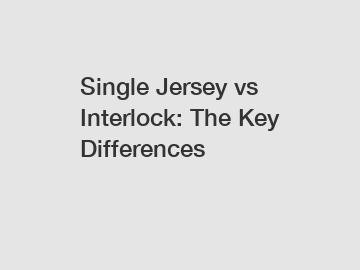Single Jersey vs Interlock: The Key Differences
As you dive into the world of fabrics, you may come across two popular choices: single jersey and interlock. These two fabrics may seem similar at first glance, but there are key differences that set them apart. In this blog post, we will explore the differences between single jersey and interlock fabrics, helping you make an informed decision when choosing the right fabric for your next project.
Single Jersey Fabric.
Single jersey fabric is one of the most common and widely used types of knitted fabric. It is made using a single needle knitting machine, which creates a fabric with a single set of needles. This results in a fabric that is lightweight, soft, and stretchy. Single jersey fabric is commonly used for t-shirts, dresses, and other lightweight garments.

One of the key characteristics of single jersey fabric is its tendency to curl at the edges. This is due to the construction of the fabric, where the front and back of the fabric have different tensions. While this curling can be controlled during the manufacturing process, it is a common feature of single jersey fabric.
Interlock Fabric.
Interlock fabric, on the other hand, is made using a double needle knitting machine, which creates a fabric with two sets of needles. This results in a fabric that is thicker and more stable than single jersey fabric. Interlock fabric is commonly used for activewear, baby clothes, and other garments that require more structure and durability.
One of the key differences between single jersey and interlock fabrics is the way they are constructed. Single jersey fabric has a smooth and flat surface on one side, with small loops on the other side. Interlock fabric, on the other hand, has a double-layer construction, with both sides of the fabric looking the same. This double-layer construction gives interlock fabric more stability and durability than single jersey fabric.
Another key difference between single jersey and interlock fabrics is their stretchiness. Single jersey fabric has more stretch than interlock fabric, making it the ideal choice for garments that require a more form-fitting and stretchy fabric. Interlock fabric, on the other hand, has less stretch but more recovery, making it ideal for garments that need more structure and support.
Choosing the Right Fabric.
When choosing between single jersey and interlock fabrics, it is important to consider the needs of your project. If you are looking for a lightweight and stretchy fabric for a t-shirt or dress, single jersey fabric may be the best choice. On the other hand, if you need a thicker and more stable fabric for activewear or baby clothes, interlock fabric may be the better option.
It is also important to consider the intended use of the garment. If the garment will be subject to a lot of stretching and movement, single jersey fabric may be more suitable. If the garment needs to retain its shape and structure, interlock fabric may be the better choice.
In conclusion, both single jersey and interlock fabrics have their own unique characteristics and benefits. By understanding the key differences between these two fabrics, you can make an informed decision when choosing the right fabric for your next project. Whether you are looking for a lightweight and stretchy fabric or a thicker and more stable fabric, there is a fabric that is perfect for your needs.
Want more information on polyester flame retardant fabric factory, fire rated jeans, fluorescent fabrics? Feel free to contact us.
130
0
0


Comments
All Comments (0)